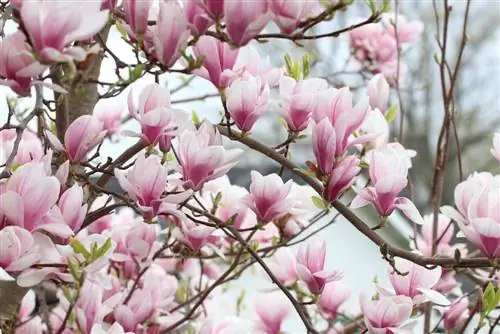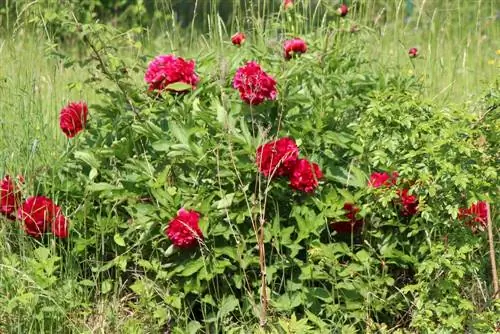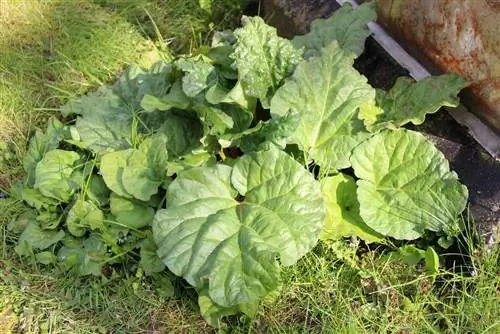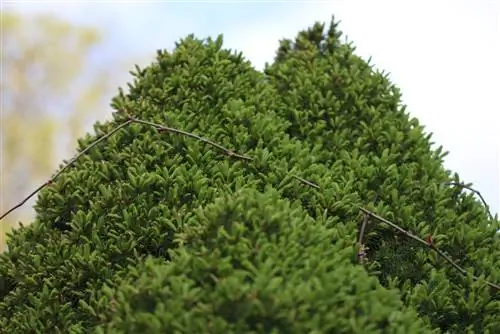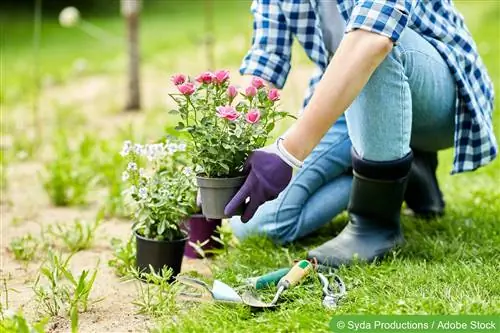- Author admin [email protected].
- Public 2023-12-17 03:39.
- Last modified 2025-01-24 12:45.
Magnolias are now available in over 100 different varieties, some of which are very robust and survive cool winters well. In addition to choosing the right type and variety of magnolia, great care should be taken to choose the right location. But there are also a lot of things to consider when planting the noble tree so that the somewhat sensitive young plant has the best conditions to grow well and develop he althy and strong. If you take the following approach and advice to heart, you will create the best conditions for your young magnolia and prevent failures.
Space requirement
A particularly important point when choosing the type or variety of magnolia is the space available. There should be enough space available for the young plant so that the tree can develop freely and develop well. For magnolia trees, an area of four to eight meters in diameter should therefore be planned, depending on whether it is a smaller form or a large-growing species. Shrub and columnar magnolias require correspondingly less space.
Location
Almost all magnolia species and varieties prefer a predominantly sunny location in the garden, although there are a few exceptions. If the location and soil conditions are right, the magnolia thrives and delights the gardener with strong growth and consistently abundant flowers. In addition, the young wood can mature well before winter, so that damage in the cold season is reduced to a minimum. Nevertheless, most species can cope with a location that does not offer sun all day long. The Siebold's magnolia (Magnolia sieboldii) and a few other species prefer sunny or semi-shady places in the garden where they are protected from the blazing midday sun. The best locations are those that offer the tree - at least when young - a certain amount of protection from strong winds but also extreme sunlight. The magnolia tree is at its best when it can grow free from neighboring plants.
- Light requirements: bright, partly partially shaded
- sufficient space to house walls and property boundaries
Wind position
Magnolia trees should preferably be placed in a place in the garden that is somewhat sheltered from the wind, without suffering from heat build-up in summer temperatures. In particular, those types of magnolias in which the flowers open before the leaves appear on the tree should not be placed in drafty places. The main thing here is to ensure that the flowers are not affected. This should also be taken into account with large-leaved magnolia species such as Magnolia macrophylla (large-leaved magnolia) or Magnolia tripetala (umbrella magnolia). Here the leaves suffer from the strong wind.
Floor
Magnolias need a nutrient-rich soil that can store water well on the one hand, but is not prone to persistent waterlogging on the other. Most magnolia species cannot tolerate longer dry periods and react by dropping leaves. Therefore, care should be taken to ensure that the soil has a high proportion of humus. If the soil is very sandy or clayey, it is therefore advisable to mix larger amounts of mature compost into the garden soil. Very heavy soils must also be mixed with sand or grit so that the water can drain off easily and the roots of the magnolia tree are sufficiently ventilated.
- good water storage capacity and still well drained
- humous and nutrient-rich
- most species prefer slightly acidic soil
Since magnolias have shallow roots, constantly moist soil is very important for their he althy growth. In summer, the ground must not warm up too much. In its natural location, the tree is protected from warming and drying out in the root area by undergrowth or falling leaves. If no underplanting is planned, the root ball should be covered with a layer of mulch. This is especially important for young plants. Older trees cast the shadow of their own canopy on their roots.
Ball or container plant
In specialist retailers, the magnolia is sold either with root balls or as a container plant. Plants with root balls grew in a tree nursery on arable land. There they were transplanted several times so that the densest possible root system was formed in a very small space. Such plants are guaranteed to continue growing quickly when they are moved from the nursery to the home garden. Ball magnolias can be planted between October and April in frost-free weather.
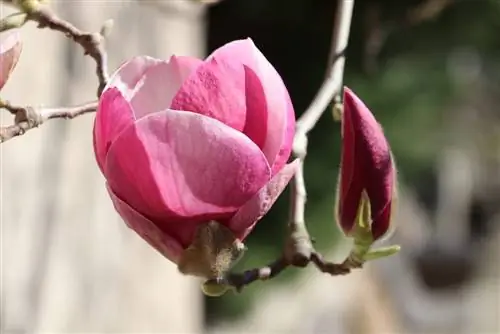
In contrast to ball plants, magnolias are grown as container plants in a plant pot. This cultivation method makes the tree more independent in its use. Container plants can generally be planted all year round as long as the garden soil is frost-free. This does not necessarily have to be a contradiction to the spring planting of ball plants.
Planting in spring is purely a precautionary measure so that the magnolia can grow in well before the cold season. All magnolias planted in late summer or autumn must be provided with winter protection. As a rule, they get through the winter unscathed, as long as there are no extreme conditions.
Planting instructions
When planting a magnolia, it is important to create perfect conditions for the young plant right from the start so that it can grow in quickly and develop well.
1. In order for the magnolia to grow well, it needs loose soil, even deep. Depending on the size of the tree, a hole about 50 to 60 cm deep and slightly wider should be dug. For very large root balls, the planting hole must be enlarged accordingly.
The rule applies:
At least three times the bale width and depth. The upper humus-rich soil layer should be stored separately when excavating (usually about a spade depth).
2. If the garden soil is quite hard or heavy, it must be loosened up under the planting hole so that water does not pool there later or the roots of the growing magnolia meet resistance.
3. Pour a 60 to 80 liter bag of potting soil with an acidic pH value and a high humus content such as rhododendron soil, azalea soil or bog soil into the planting hole. In addition, around a third of the separately stored top layer of humus comes from the excavated earth. Both are mixed well with the spade.
4. The well-watered root ball or the potted container plant is now placed on this layer of soil in the middle of the planting hole. Beforehand, the earth is shaken out of the ball a little and the roots are carefully loosened. When planting, it is important to pay attention to the planting depth. The magnolia must not be planted much deeper than the original ground level of the bale. For good watering, it has proven useful to set the root ball level about one to two centimeters below the rest of the soil level.
5. For larger magnolia trees (from a height of around 1.75 meters) one to three stabilization posts should be installed. The roots must not be damaged or affected during insertion. Tree supports help the young magnolia to develop strong roots and grow well. Because the root system needs at least one growth period until it is firmly anchored in the ground.
6. The stake is driven in as soon as the magnolia is in the planting hole. It is best to place the support in the main wind direction. It must be driven at least 60 cm deep into the ground and end below the crown so that the post does not rub against the sensitive shoots in the wind and injure them.
7. If the tree support is accidentally forgotten when planting, it can be installed later. In order not to injure the roots, the post is driven in at an angle of about 45 degrees.
8. The remaining excavated earth and the humus layer are now filled into the planting hole in layers. It may be necessary to add compost or grit to the soil beforehand to optimize the soil properties. The soil is filled in a circle around the root ball of the magnolia and lightly trampled. If the angle of inclination of the magnolia tree trunk or the support changes, this can still be corrected.
9. The trunk of the magnolia is connected to the tree support using coconut rope or rubber band. The lacing must not be too tight so that the trunk is not squeezed as it grows wider.
10. A groove about 5 cm deep is made around the planting hole. This ditch is used for better irrigation during the growing phase.
11. If the young magnolia is currently in the ground, water carefully again without washing out the substrate.
Tip: The tree supports can be removed after about two to three years. Now the rooting is complete and the magnolia tree is well anchored in the ground.
Care
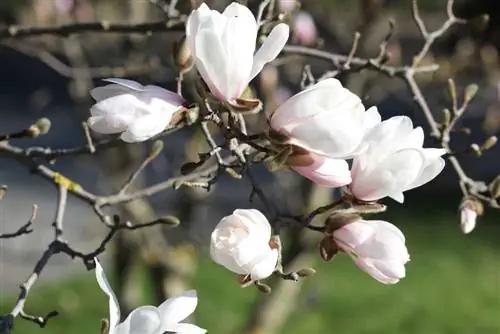
After planting, the soil must be kept evenly moist. No additional fertilizer is required during the planting year. Fertilizing can begin slowly in the spring of the second year.
- mix mature compost into the soil
- alternatively add rhododendron fertilizer
- use other organic-mineral fertilizers for flowering shrubs
Tip:
It is best to use a fertilizer that is suitable for acidic soil locations. These fertilizers contain components that keep the pH of the soil at a consistently acidic level.
Transplanting magnolias
Basically, trees like magnolias should not be transplanted. Once the heart-shaped root has firmly anchored itself in the soil, there is a risk that large areas of the roots will be damaged or cut off when digging. This weakens the tree enormously. If the damage is particularly severe, the magnolia cannot grow into the new location and will die sooner or later.
However, there are a few exceptions where it is urgently necessary to move a magnolia tree to another location. This can be the case, for example, if it was accidentally planted too close to a building. Of course, all magnolias that become diseased or do not grow properly due to the wrong choice of location must also be transplanted.
- Time: Spring or Autumn
- Magnolias form a relatively shallow root system
- the sooner the magnolia is transplanted, the better
- relatively freshly planted trees are easier to transplant
- Radius for plants that have only been in the location for two to three years: about 40 cm
- special measures are necessary for older, well-established plants
- In the spring, stick a spade deep into the ground around the trunk
- Radius: about 50 cm
- The magnolia then forms young roots there
- dig up the tree and transplant it the following spring
- carry out a plant cut after moving
For older magnolia trees, this method is more promising than digging them out directly. Depending on its size, the tree needs around two to three years to recover. Therefore, it is very important to water the plant regularly after transplanting.
Plant cutting
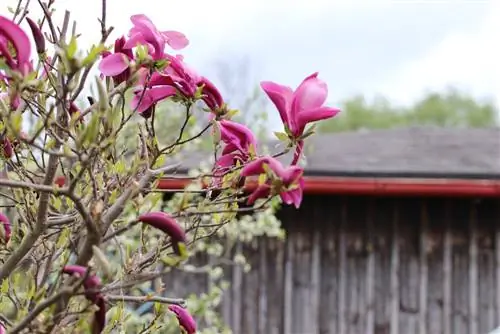
If you transplant a well-established, older magnolia, you have to expect failures when temperatures rise and a lot of water evaporates through the foliage. The most common reason for the death of transplanted trees is drying out. This happens because the roots of the magnolia are not yet in sufficient contact with the soil and therefore cannot absorb the irrigation water well. So there is no replenishment for the moisture lost through the leaves. The only remedy here is a plant cut, which greatly limits evaporation through the leaves.
- Trees with a continuous leader: do not shorten the leader
- strongly branched crown: shorten all shoots by about 1/3
- pay attention to the typical crown shape of the magnolia
- shorten long, unbranched branches more
- always cut above an eye/side shoot that faces outwards
- Use a sharp, clean cutting tool
- Make sure the cut surfaces are as small and smooth as possible
Conclusion
The location for the magnolia should be selected with great sensitivity, because only the right place in the garden and the right soil conditions ensure he althy and strong growth of the magnolia and protect the tree from damage in winter. Two things are particularly important when planting: the right time and good soil preparation. If both are correct, the magnolia will usually grow well.

